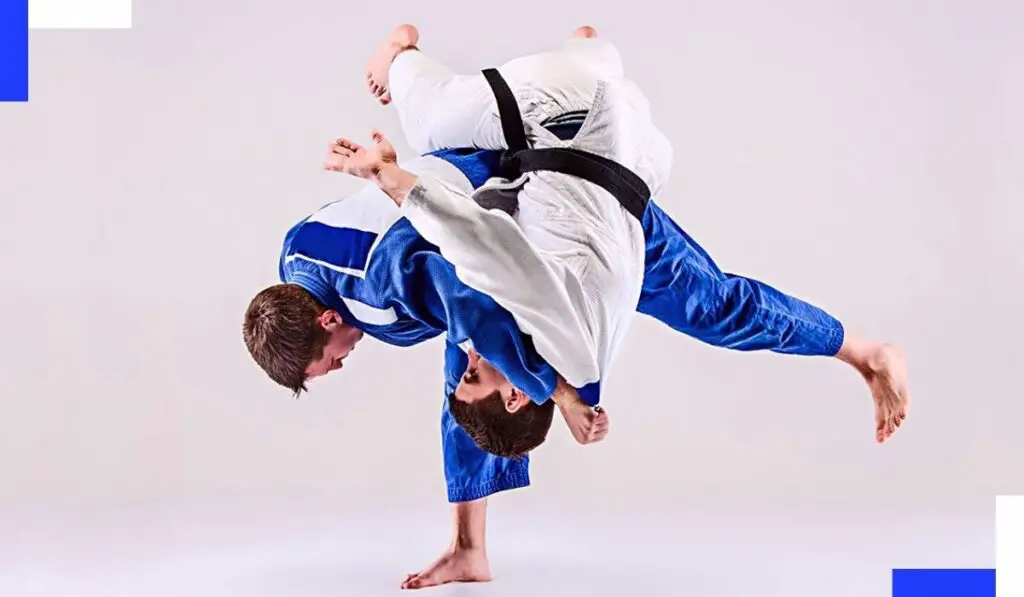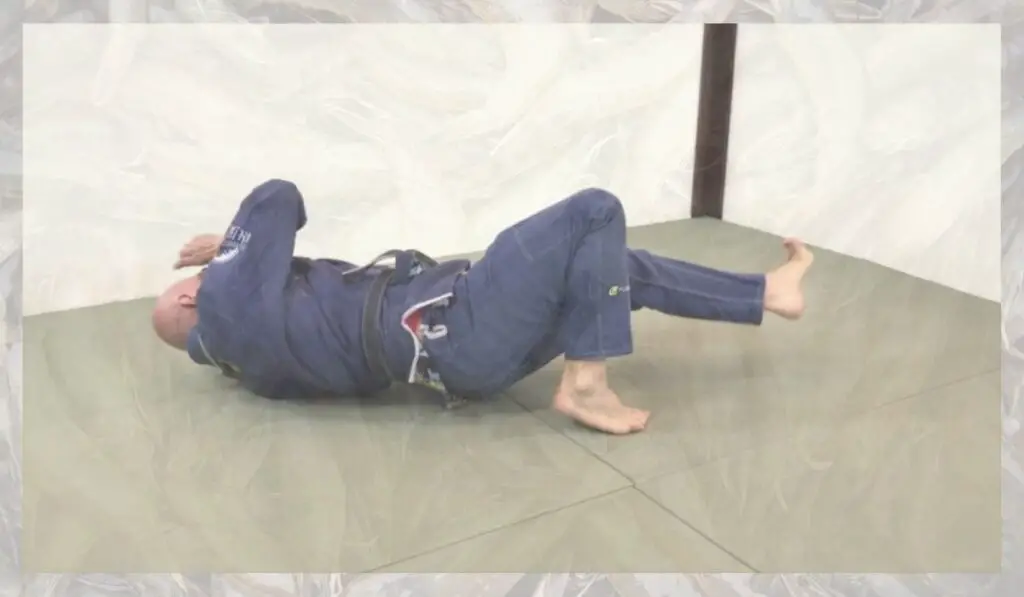Brazilian Jiu-Jitsu is a vigorous activity with so many unusual moves. You don’t see people rolling or doing the all-four walks down the street. Instead, those usual movements will fire your body and brain. More calories are burned in jiu-jitsu than in jogging or basketball.
Jiu-Jitsu exercise burns anywhere from 800 to 1000 Calories an hour, depending on your size, weight, and length of training.
But it’s hard to calculate precisely how many calories jiu-jitsu burns because of different activities and training sessions. For example, you won’t fight for the air after 10 minutes of stretching, but your heart will pump like crazy after three or more submission switch attempts in a row.
This article will focus on energy expenditure and calories burned in BJJ workouts. Karsten Overtveit is the leading BJJ researcher, but data are still limited compared to published reports on Judo, Muay Thai, and other martial arts.
How Many Calories Does Jiu-Jitsu Burn?

Brazilian Jiu-Jitsu burns anywhere from 800 to 1000 Calories an hour. It is a high-intensity full-body workout that requires minimal equipment.
| BJJ Training Time Per Minutes | BJJ Burned Calories |
|---|---|
| 15 | 200 – 250 |
| 30 | 400 – 500 |
| 45 | 600 – 750 |
| 60 | 800 – 1000 |
| 75 | 1000 – 1250 |
| 100 | 1200 – 1500 |
Jiu-jitsu relies on grappling and groundwork to bring down an opponent. Use leverage and technique to control your opponent, and then apply a submission hold or joint lock technique to force them into submission.
The calories burned in Jiu-Jitsu depend on how hard you train, weight, body type, age, and other factors.
On the other hand, some game areas could make your weight cut super easy since it burns more calories than other activities. Here are the fundamental aspects of jiu-jitsu:
- Stretching – a very light activity that improves your flexibility;
- Calisthenics – a variety of movements for fair muscle groups;
- BJJ technique – learning new moves or perfecting old ones;
- Top control – staying in closed guard, side control, mount, or another dominant position, plus disabling the opponent from escaping off his back;
- Working off the bottom – sweeps, transitions, or submissions off your back;
- Submission switch – attempting, for example, armbar to Kimura or some other technique, connecting two or more techniques to make your opponent tap;
- Standing submission game – the tricky part of the game, you are dealing with the force of gravity too;
- Stalling (gi BJJ) – holding the position without blatant submission attempts;
- Competition (sparring) – trying to defeat your rival via BJJ rules in combat.
Stretching and stalling (experienced fighters) spare your energy and let you recover.
On the other hand, submission switches, standing submission game, and working off the bottom are more demanding than, for example, toe-to-toe boxing fights. Nobody will let you sink your hand under his neck.
Related: Don’t put it off any longer; check out the list of the finest jiu-jitsu strength and conditioning workouts. Regularly integrating these workouts into your BJJ training program can help you become a stronger and more competitive grappler. Click here for further information!
How Many Calories Does Grappling Burn?
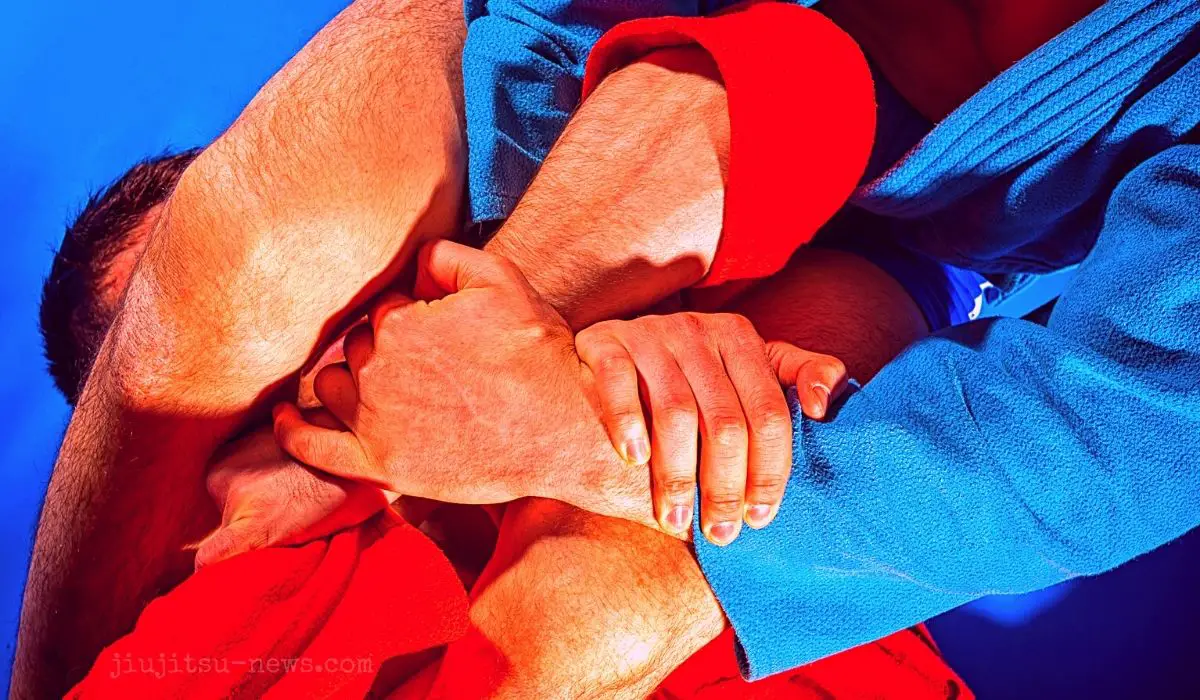
It depends on the training’s intensity. For example, standing grappling (standing body triangle, rear-naked choke, guillotine choke) kills your cardio.
We suggest watching the UFC Vegas 30 fight between Kennedy Nzechukwu and Danilo Marques. Marques was trying to finish Nzechukwu via standing rear-naked choke for two rounds. But he gassed in the third and ended up on the canvas after a barrage of violent punches.
On the other hand, digging for the under-hooks or butterfly to complete guard transition will not affect your heart rate.
The lack of skill matters too. Imagine a white belt grappling against a brown or blue belt. The poor knowledge will force the beginner to activate more muscles and waste more energy to perform a successful sweep or defend a submission attempt.
Experienced athletes develop more explosive leg strength and isometric handgrip than newbies. Plus, peripheral fatigue is way more dangerous than massive lactic acid levels in your quads or gluteal muscles.
Maximal strength training (1-5 repetitions per set, 87-100% of 1 repetition maximum) will improve BJJ grapplers‘ levels of power and strength.
Strength matters, but technique comes first, leading to better muscular endurance and top-notch stamina!
The answer to this question is pretty much relative, and it depends on many factors. But you can call grappling an intermediate activity as training sessions mainly consist of technical aspects of the game.
The formula for the estimated energy expenditure looks like this:
(activity index x your bodyweight (lbs)) / 60 x (activity time (minutes))
Example:
(3.25 x 170 lbs) / 60 x 10 = 92 kcal for 10 minutes of grappling
Related: You should know the potential health risks if you’re considering starting Brazilian jiu-jitsu. While BJJ can provide tremendous physical and mental benefits, it has drawbacks. Click here to read more!
How Many Jiu-Jitsu Calories Does Rolling Burn?
When rolling on the mat, a 200-pound BJJ student may burn about 1000 Calories per hour. Yet, The jiu-jitsu burned calories are affected by the trainee’s weight, body type, age, and other factors.
Rolling is easier as you deal with a smaller force of gravity than the standing BJJ game. As a result, you can stay on the top of your opponent or stall, especially in a gi fight.
The fighter with proper technique will spare the energy by activating bigger muscle groups during stalling or top control. On the other hand, an amateur defends most sweep/transition attempts via his arms and shoulders, which leads to massive energy expenditure.
An experienced fighter who leads on the scorecards will probably do enough to stop the ref from getting the fight back to standing. Overall, the BJJ community considers rolling “an intense” activity.
You rolled for 15 minutes, and you weighed around 200 lbs. Here is the formula:
(4.87 x 200) / 60 x 15 = 243,5 kcal (quite an impressive score, isn’t it?)
Related: Are you gaining some pounds and wondering whether Brazilian jiu-jitsu will help you lose weight and get ripped? This article will help you get ripped while training BJJ. Click here to read more!
How Many Calories Are Burned In 1 Hour of Jiu-Jitsu?
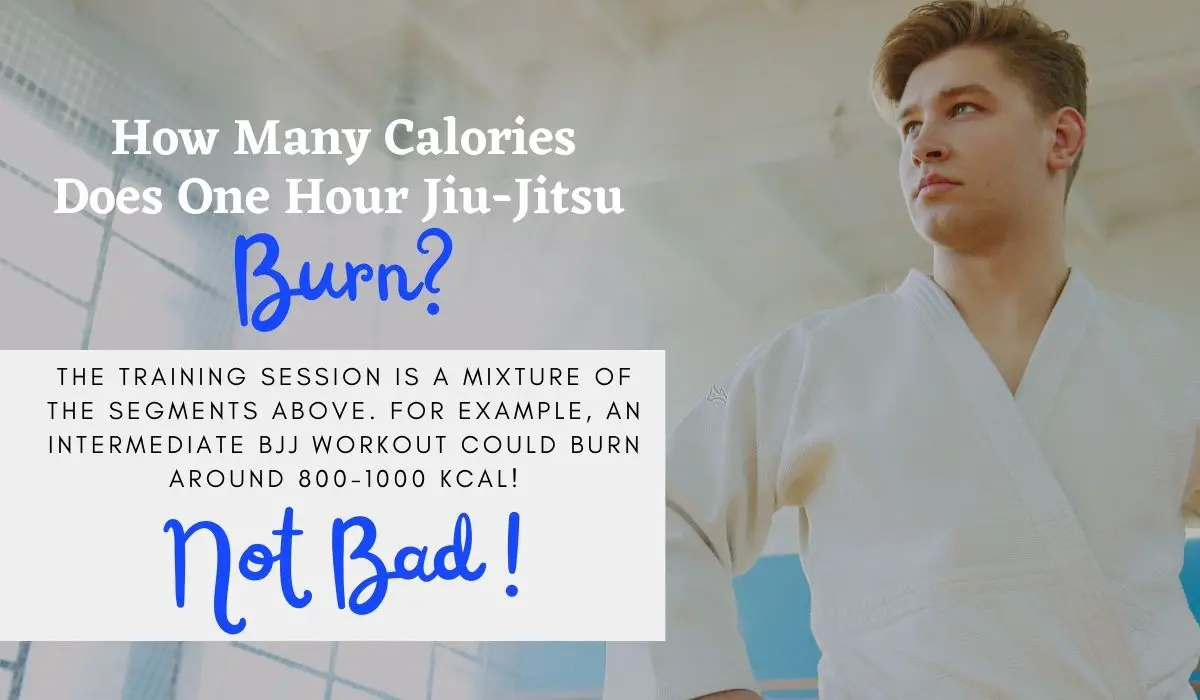
The training session is a mixture of the segments above. For example, an intermediate BJJ workout could burn around 800-1000 kcal!
Beginners will waste more energy due to a lack of technicality. Yet, they’ll gas out earlier. Please note it’s impossible to compete or attempt submission switches for 60 minutes non-stop.
The formula for one-hour BJJ burned calories again, but values are estimated.
Energy expenditure per hour = activity index x your body weight (lbs)
| Activity | Approximate Index | Approximate Value (200 lbs person) |
| Stretching | 1.81 | 362 kcal |
| Calisthenics | 2.43 | 486 kcal |
| Grappling (technical session) | 3.25 | 670 kcal |
| Rolling | 4.87 | 974 kcal |
| Sparring (Competition) | 15-20 | 3000-4000 kcal |
| Stalling/top control | 3.0-3.5 | 600-800 kcal |
| Standing submission/submission switch | 8-12 | 1600-2400 kcal |
| Working off the bottom | 5-7 | 1000-1400 kcal |
Is Jiu-Jitsu a Good Workout?
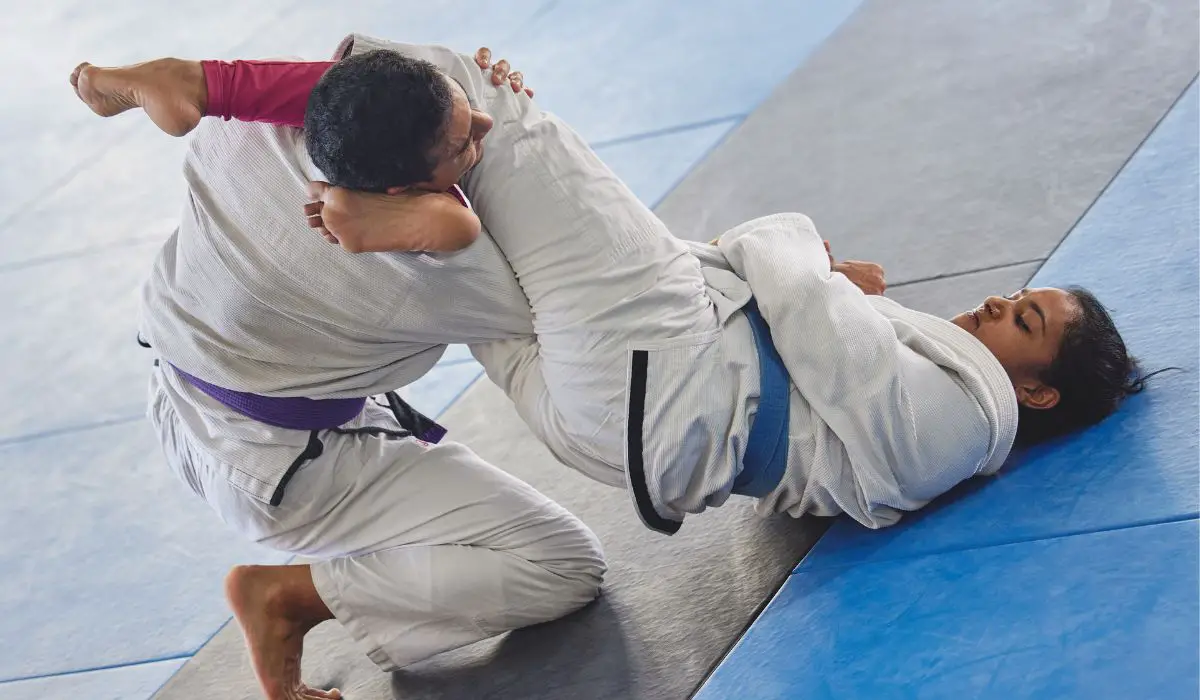
Jiu-jitsu is a martial art that focuses on grappling and ground fighting. This type of martial art is an excellent workout for the body, but it also has many benefits for the mind.
Aside from that, it’s a great way to relieve stress and anxiety and develop self-confidence.
Here are some convincing reasons why BJJ is an excellent workout for you:
- First, it activates your whole body (especially standing sweeps and transitions).
- Jiu-jitsu helps you beat bigger opponents because technique comes first – good for self-defense and self-confidence.
- You’ll look ripped; jiu-jitsu activates all core and lower back muscles.
- BJJ decreases blood pressure and levels of stress.
- If you decide to compete at BJJ, fight or flight situations will happen from time to time. It will strengthen you mentally. You will be more responsible in real life.
- You’ll get to know people with the same passion in the dojo (your potential new friends).
Related: Apart from being a highly social grappling sport, jiu-jitsu is a terrific workout to improve your fitness and reduce weight. Click here to learn more!
Can You Lose Weight Doing Jiu-Jitsu?
Jiu-jitsu burns a lot of calories. So you’ll lose fat and weight quickly, especially if you have never trained. One hour of an average BJJ session three times per week, and you’ll start noticing massive changes after a month or two.
Fighters transitioning to BJJ from different martial arts will lose fat faster than grapplers returning after the break. Beginners lose weight faster too.
Of course, you must pay attention to your nutrition, but this vigorous activity can make you more muscular and handsome.
Related: Muay Thai, Brazilian Jiu-Jitsu, Krav Maga, Kickboxing, Taekwondo, and Karate are practical martial arts for weight loss and fat burning. Click here to learn more!
Conclusion
Jiu-jitsu burns a lot of calories. So you’ll lose fat and weight quickly, especially if you have never trained. You’ll start noticing massive changes after a month or two of training.
Although, Brazilian jiu-jitsu is not an easy sport. You don’t see shrimps or rolls in the street; these moves include muscles that have never worked.
The burned calories in BJJ sessions are not restricted to the rolling rounds. It also includes time spent warming up and stretching before and after training, among other things.
Furthermore, jiu-jitsu burns more or fewer calories depending on the trainee’s weight, body type, age, and other variables.
Nevertheless, here are some interesting facts we have learned so far about BJJ calories burned in training sessions and weight loss:
- One hour of BJJ could burn 800-1000 kcal. Numbers can go up when the coach intensifies training sessions.
- Jiu-jitsu is a great way to lose your fat and look more ripped.
- The heavier person burns more calories in the same BJJ session.
- Grappling burns fewer calories than rolling. Competitions and standing submissions are the most demanding areas, alongside submission switches and the bottom game.
- There are many positive effects of BJJ on your overall development.
Would you like to lose some weight? Buy some of our products, and visit your local dojo! Give BJJ a shot, and tell us your story in the comments below!
Related: Brazillian Jiu-Jitsu is one of the most remarkable grappling martial arts to learn. Therefore, I’ve created a lengthy post on how to begin practicing jiu-jitsu correctly. Click here to read more!

